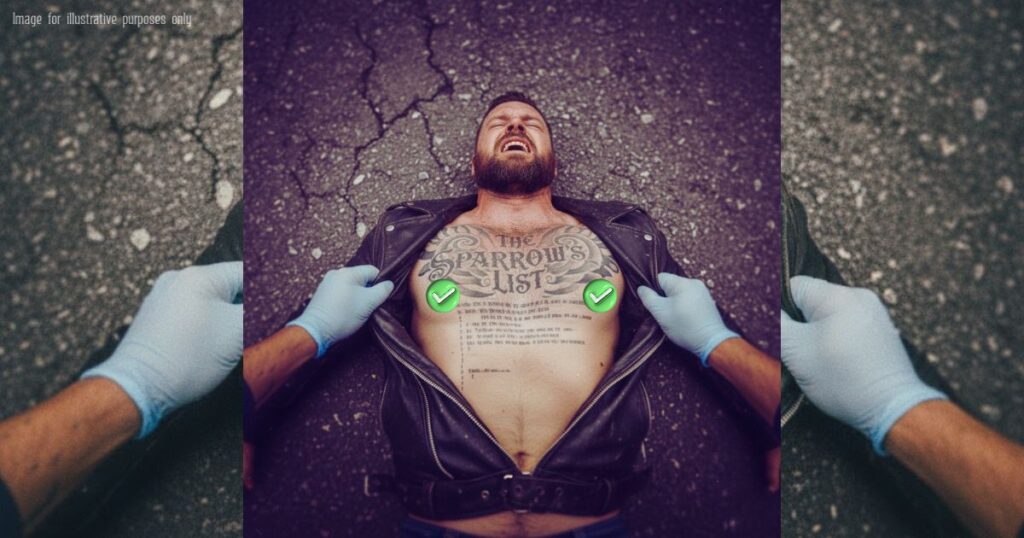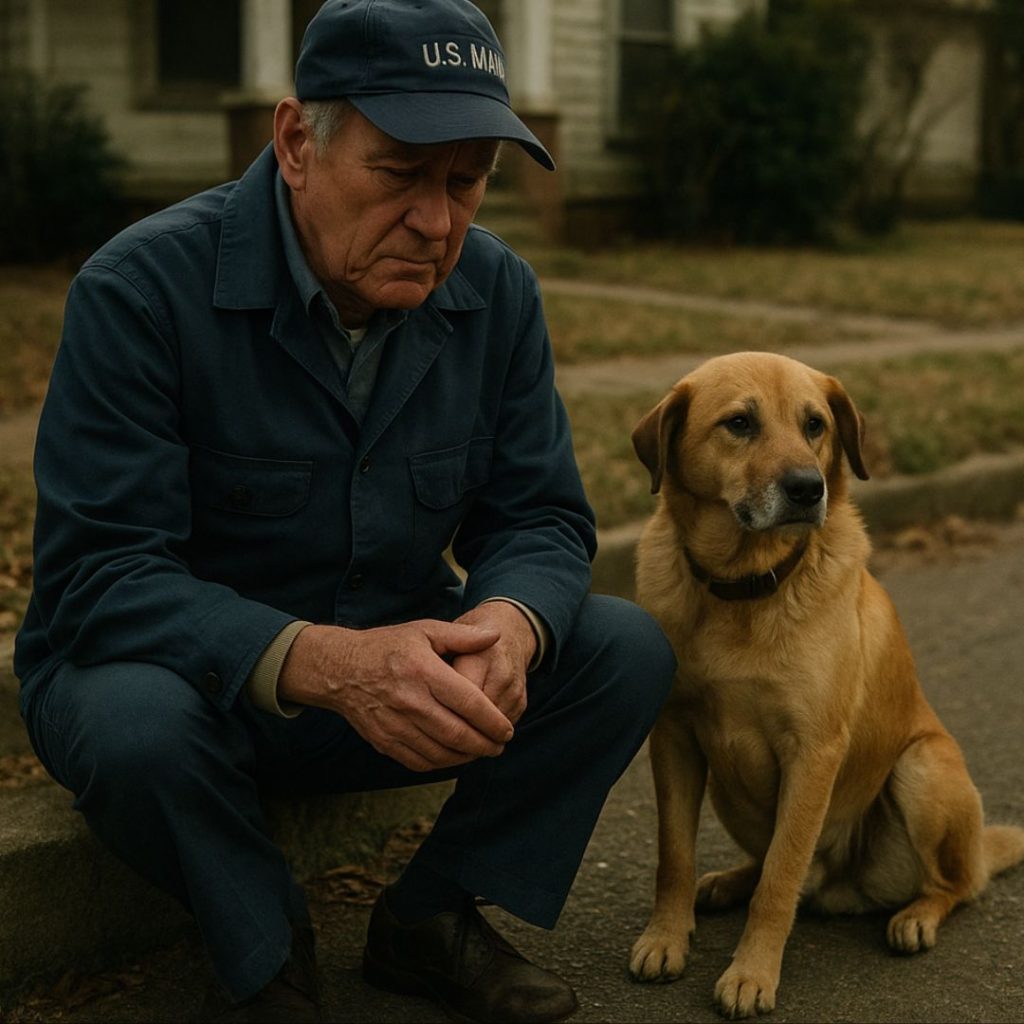I watched Marcus “Reaper” Cole, President of the Oakhaven Sentinels Motorcycle Club, die on the scorched asphalt of Civic Plaza. He died forcing his thousand-pound motorcycle into the front wheel of a runaway dump truck to save a crowd of protestors who, just moments before, had been screaming for his arrest.
It wasn’t until the paramedics cut away his leather vest and I saw the intricate, coded list tattooed over his heart that I understood he wasn’t saving his enemies. He was saving his family.
My name is Ben Kessler. I’m a journalist. Or at least, I was trying to be. I came to Oakhaven with a chip on my shoulder and a camera in my hand, ready to write the exposé that would make my career.
My target was Reaper and his Sentinels. In my mind, they were the last gasp of a dying ideology. They were loud, they were intimidating, and they had gathered in the plaza to “defend” a bronze statue of a long-dead general that the town’s progressive wing wanted removed.
I stood with the protestors, the “Civic Renewal” group. We were the good guys. We were young, educated, and on the right side of history. They were the bad guys. It was all very simple.
That Tuesday was hot, the air thick with humidity and mutual hatred. The two sides were separated by a flimsy line of police tape and about twenty feet of asphalt. Chants echoed off the brick buildings. “Tear it down!” screamed one side. “Protect our heritage!” roared the other.
I was filming Reaper himself. He was the archetype of my story. Forty-something, a neck thick as a tree trunk, and eyes that looked like they’d seen too much and cared too little. He sat on his polished black motorcycle, engine rumbling, just watching us.
His very presence was an act of intimidation. I zoomed in on his face, capturing the sneer I knew my readers would despise. “This,” I muttered to my camera, “is the face of intolerance.”
That’s when I heard it. Not a shout, but a sound that didn’t belong. The high-pitched scream of a truck’s air horn, held down, continuous.
I panned my camera up. High on the hill that overlooked the plaza, a massive, dual-axle construction truck had lost its brakes. It was barreling toward us at over fifty miles an hour.
The crowd hadn’t seen it yet. They were still screaming at the bikers. The police were facing the wrong way.
I froze. I’m ashamed to admit it, but I just stood there, camera rolling. My brain couldn’t process the physics. The truck was aimed directly at the “Civic Renewal” group. Directly at me.
Then I saw him. Reaper.
He wasn’t frozen. He didn’t hesitate. He didn’t check to see who the truck was going to hit. He just acted.
He roared his engine, a sound like a dragon waking up, and dropped the clutch. He wasn’t riding away from the danger. He was riding directly into its path.
He cut across the plaza, a black-and-chrome blur. The truck driver, wild-eyed, saw him. But Reaper wasn’t trying to get past.
He aimed his bike, his body, at the truck’s front steering axle.
In that last millisecond, I understood his geometry. He wasn’t trying to stop the truck. He was trying to turn it.
The impact was sickening. It wasn’t a metallic crash, but a heavy, final thud. Reaper’s motorcycle disintegrated. He was thrown fifty feet, a broken doll in black leather.
The truck’s front wheel, deflected by the impact, slammed into the granite base of the very statue they were all fighting over. The truck jackknifed, screeching, and came to a stop.
Its bed, loaded with gravel, had missed the crowd by less than three feet.
Silence. Then the screaming started, but it was a different kind of screaming now.
I was shaking, my camera still recording from the strap around my neck. I walked, stumbled, toward the wreckage. The truck driver was slumped over the wheel, but he was moving.
But Reaper… he wasn’t.
He lay on the bricks, a ruin of a man. His club members, his “Sentinels,” were running toward him, shouting his name. The protestors—the people he had just saved—were clutching each other, sobbing in disbelief.
I watched as a young EMT, barely twenty, arrived. He and his partner got to work. “I need to open his airway! Cut the vest!”
The EMT took his trauma shears and ripped through the heavy leather vest, the “Sentinels” patch, and the denim shirt beneath.
I angled my camera, zooming in. I don’t know what I expected to see. Hateful symbols. Gang affiliations. Something to confirm the story I had already written in my head.
What I saw stopped my breath.
It wasn’t a symbol. It was a list. An intricate, precise tattoo that covered the entire left side of his chest, over his heart. It was titled:
THE SPARROW’S LIST
Below it were five lines of meticulous code. SPARROW-01: A-INS / R-Type / 4x / File: 9942-B SPARROW-02: K-LOR / 20mEq / 2x / File: 8817-G SPARROW-03: E-STAT / 100mg / 1x / File: 4209-A SPARROW-04: B-PUL / 50mcg / 3x / File: 2112-R SPARROW-05: G-TROP / 2.5mg / 1x / File: 7730-C
It looked like military code. A drug formula. A criminal ledger.
Then he opened his eyes. He wasn’t dead. Not yet. His eyes found me, found the blinking red light of my camera. He didn’t seem to care.
His hand, covered in blood, shot out and grabbed my wrist. His grip was impossible.
“My phone,” he rasped, his voice a wet rattle. “Left pocket… Call ‘Chaplain.’ He’s in the crowd.”
I was too stunned to move. He squeezed my wrist tighter. “Do it. Now.”
I fumbled for his phone. It was cracked, but it worked. I found “Chaplain” in his contacts and hit call. I put it to my ear.
“What?” a rough voice barked.
“He’s… Reaper. He wants to talk to you,” I stammered.
I put the phone near Reaper’s mouth as the EMTs tried to put a C-collar on him.
“Chap…” Reaper coughed, blood spotting his lips. “Listen. The ‘Sparrow’ run… it’s funded. The build-off money… it’s in the account.”
Chaplain was yelling on the other end, but Reaper kept talking, his words for me as much as for the phone.
“The codes… on my chest. They’re the files. Don’t… don’t let them lose the files. The kids…”
His eyes rolled back. The EMTs pushed me away. “He’s in V-fib! Charging!”
I stood back, clutching my camera, my mind reeling. Kids? What did kids have to play in this? This was a drug deal gone wrong. It had to be.
Marcus “Reaper” Cole was pronounced dead at 11:14 AM, on the bricks of Civic Plaza, surrounded by his enemies.
My editor was ecstatic. “A Biker Warlord Dies Saving His Enemies! Ben, this is huge! And this ‘Sparrow’s List’? It’s a goldmine! Drugs? Weapons? What is it? Find out!”
I started my investigation, but I wasn’t a journalist anymore. I was a witness. I was the man holding the last words of a dead hero.
His real name was Marcus Cole. Age 42. I pulled his military record. Dishonorably discharged. The pieces fit my original story. A violent man, kicked out of the service, who started a violent club.
I found “Chaplain” at the Sentinel’s clubhouse, a grim-looking warehouse by the county line. His real name was Elias Thorne. He was huge, with a beard down to his chest and tears streaming silently into it.
“I was with him,” I said, my voice small. “He told me to call you. He told me the run was funded.”
Chaplain looked at me, his eyes red and swollen. I expected him to hit me, to throw me out. I was the enemy, the media, the one who filmed his friend’s death.
Instead, he just sank onto a barstool. “Funded,” he whispered, and let out a sound that was half-sob, half-laugh. “Of course he did. He finished the job. He always finished the job.”
“What job?” I asked. “What is the Sparrow’s List?”
Chaplain pointed a thick finger at me. “You turn that camera off. You turn it off, or I’ll throw it through that wall.”
I turned it off.
“You media guys… you come here thinking you know everything,” he said, his voice thick with grief. “You see leather, you see a beard, and you see a monster. You never once stopped to ask why we were at that plaza.”
“You were there for the statue,” I said.
“To hell with the statue!” he roared, slamming his fist on the bar. “We were there because she was there.”
He pulled out his phone and showed me a picture. A text message. It was a photo of a young, terrified-looking woman holding a protest sign.
“This is Ana,” Chaplain said. “She was leading the ‘Civic Renewal’ rally. She’s ‘Sparrow-03’s’ mom.”
My blood ran cold. “Sparrow…03?”
Chaplain stood up and walked to a massive whiteboard in the back room, hidden from view. It was covered in the same codes I saw on Reaper’s chest. But it wasn’t a drug ledger.
It was a battle plan. The columns were: Child’s Name, Condition, Pharmacy Corp, Insurance Denied, Appeal Date, Grant Deadline.
“Oakhaven General shut down its pediatric cardiac wing two years ago,” Chaplain said. “A private equity firm from New York bought it. Said kids weren’t ‘high-margin.’ Nearest specialist is 200 miles away. These kids… their families were told to ‘make arrangements.'”
He pointed to the first line. “Sparrow-01. Maya. Type-1 Diabetes. Insurance deductible is $8,000. Her mom’s a waitress. She was rationing her daughter’s insulin. We found her when she started a GoFundMe for $500.”
“Sparrow-02. Kevin. Leukemia. Insurance refused the ‘experimental’ treatment. We found him.”
“Sparrow-03. Leah. That’s Ana’s daughter. A hole in her heart. The firm that bought the hospital tripled the cost of the surgery. Ana’s insurance said ‘pre-existing condition.’ She was trying to sell her apartment.”
I looked at the codes on my camera’s playback screen. A-INS. K-LOR. E-STAT. They weren’t drug names. They were abbreviations for the life-saving medicines they needed.
“But… how?” I whispered. “What do you do?”
“What do we do?” Chaplain said, a grim pride in his voice. “We’re the Sentinels. We fight. But we don’t fight protestors. We fight bullies.”
“Reaper was a genius with paperwork. He got that dishonorable discharge fighting for a private his CO was trying to bury. He hated the system. So he learned to beat it.”
Continue Reading 📘 Part 2 …


